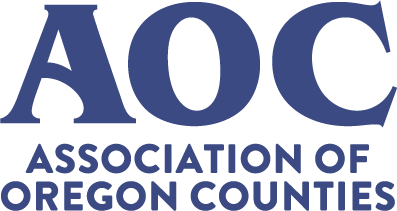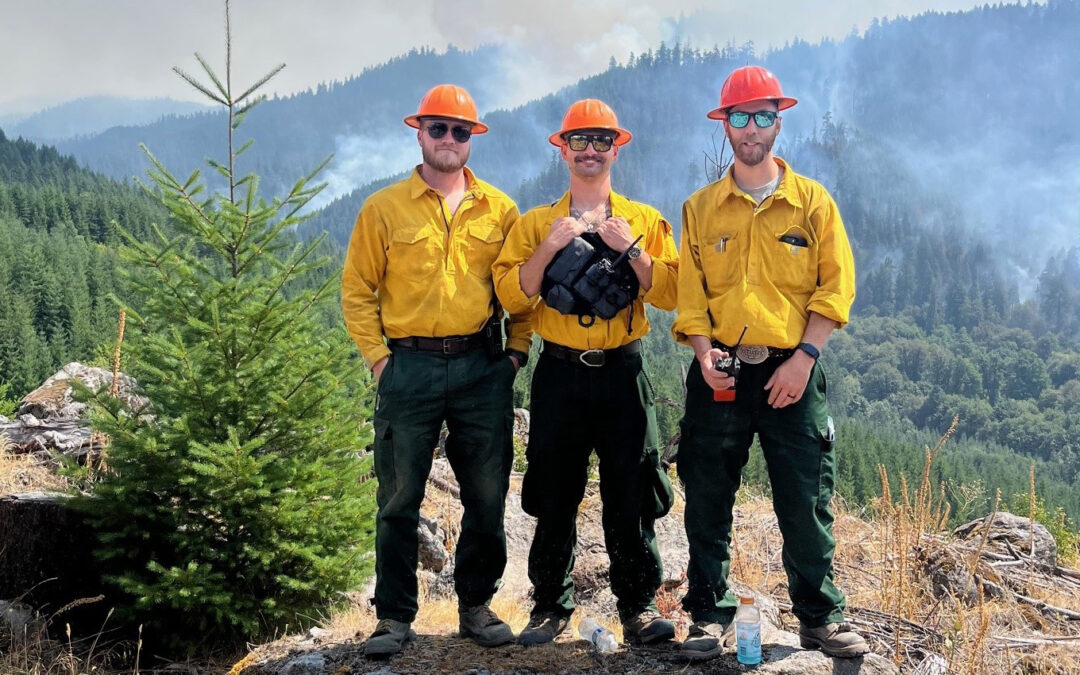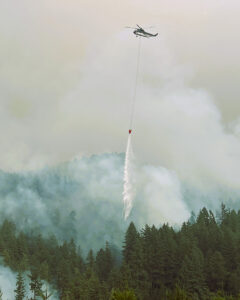(Pictured above: Weston Tilton, roads manager; Niko Monaco, silviculture forester; and Dylan Johnson, forester, on our Springfield tree farm in Oregon. Smoke from a wildfire is visible in the background.)
Sponsored content contributed by AOC Business Partner: Weyerhaeuser
In September 2020, the Holiday Farm Fire burned across nearly 166,000 forested acres in Oregon. Some of those impacted acres — including some acres of Weyerhaeuser land — were so damaged the soil couldn’t hold water. That meant many seedlings planted there would not survive.
“As foresters, we put our hearts and souls into these places, so it’s devastating to see them like that,” says Nate Meehan, a forest engineering specialist in Oregon’s Mid Coast tree farm. “But that’s also what motivates us to keep going, no matter what challenges we face.”
Post-wildfire recovery on Weyerhaeuser’s impacted tree farms — Springfield, Snow Peak, South Valley and Clackamas — is a long-term process requiring patience, collaboration and experimentation. All while the next wildfire season looms just around the corner.
“Fire prevention and readiness is top of mind, and we’ve worked very hard to increase our capacity to respond while also working on reforestation,” says Niko Monaco, a silviculture forester in Springfield. “Nothing has been more important than building strong relationships with each other, with our state and federal partners, and with the contractors who jump into action with us when needed.”
MAKING UP FOR LOST TIME
The Holiday Farm Fire footprint is significant, and replanting damaged areas requires a massive influx of tiny new trees. Weyerhaeuser’s Springfield tree farm alone plants an average of five million seedlings each year; most of our other Oregon tree farms plant one or two million seedlings.
To help get trees in the ground, everyone on the Springfield forestry team has dedicated extra time to replanting and recovery. Each of Springfield’s foresters is a lead on a large recovery project.
“Fires tend to spark growth of new competing species that can be more tenacious than the previous ones that grew in those areas, taking moisture and nutrients away from our seedlings,” says Dylan Johnson, who’s overseeing vegetation management for Springfield. “And that’s just one complicating factor converging with many others.”
Weather also complicates things. The summer of 2022 brought drought and unusually high temperatures, which caused widespread mortality of newly planted seedlings. The Springfield team worked to understand the size and quality they needed in their replacement trees to help them survive, then replanted the areas most affected. They’re making steady progress despite such setbacks, whittling the initial estimated recovery time from seven years down to four.
“It’s a passion project for many of us, and everyone involved is doing a phenomenal job,” Niko says. “It’s amazing to see such dedication and determination at work.”
TAKING PROACTIVE STEPS TOGETHER
Working hard on recovery efforts while simultaneously planning for future fires is hard both mentally and emotionally on our employees and contractors. But they say they’re buoyed by the sense everyone is in it together — not just within Weyerhaeuser, but across the entire industry.
“During the Holiday Farm Fire, I worked shoulder to shoulder with our competitors,” Nate says. “We were completely synchronized, putting every ounce of our energy into fighting the fire. Without our combined numbers and prevention efforts on our own lands, the government would have a much harder time controlling the wildfires that occur nearly every year now.”
Over the last four years, our Oregon tree farms have improved their strategies and tools, which include hoses, pumps, water tenders, fire engines, helicopters and heli-ponds that provide a source of water when needed. And our Aviation team has long played a critical role in controlling the spread of wildfire on our property.
“Many wildland fires take place in hot, high and radical terrain, which makes it difficult to reach them,” says Michael Stephens, chief pilot for Western Timberlands Aviation. “In order to respond, our Aviation team spends a lot of time on training and certification each year. It’s a lot of pressure, and pilots need to have the skills and competencies to fly this mission safely.”
Historically, our Aviation team has been dedicated to fires on our property. But a new Industrial Resource Agreement with the Oregon Department of Forestry allows certified private contracting crews to put out fires on state lands, which are often adjacent to our farms.
“The ODF contract has been beneficial in that our team is able to reach fires before they involve our property and spread to nearby communities,” Michael says.
Nate agrees and is excited about the new levels of partnership the agreement unlocks.
“It’s a win-win, because it gives our planting and harvest crews paid work in their off-season,” Nate says. “I’m also involved in the ODF’s Local Resource Boss program, which allows me to direct crews and other resources to an ODF-controlled fire. That sense of partnership is crucial to our success.”
LIGHTENING THE LOAD
As more employees gain wildfire experience and firefighting certification, the burden of keeping our property and communities safe can be spread between more people.
“Of course, those of us in the company who respond to fires when needed don’t have quite the level of stress that professional wildland firefighters have, but events like the Holiday Farm Fire can still be traumatizing,” Nate says. “I’m so glad we can turn to resources like the Fighting Fires Together Campaign to get support if we need it. It could change somebody’s life.”
Now in its third year, Fighting Fires Together is a partnership between Weyerhaeuser and Firefighter Behavioral Health Alliance to help provide specialized support and mental health resources for wildland firefighters. Free resources are available to support the mental health of firefighters, their families and their communities through mental health tips and resources, community groups, occupationally aware mental health professionals and more.
“It’s a big step just to have a conversation about firefighting and mental health,” Niko says. “No one was really talking about it until just a couple years ago, and it’s refreshing to get it out in the open.”
(Pictured above: A helicopter drops water on the Bedrock Fire last year. “I feel really lucky with the relationships we have here,” Dylan says. “During last year’s Bedrock Fire, we had to call contractors at 5 p.m. and ask them to come out with their equipment. We said, ‘We need your help or this fire is going to burn our property.’ And they showed up early the next morning with smiles on their faces and machines at the ready.”)
Contributed by: Stephanie Rogers, Weyerhaeuser


